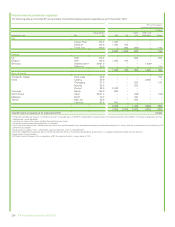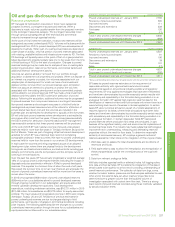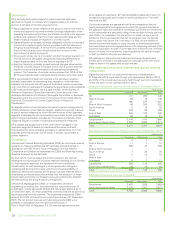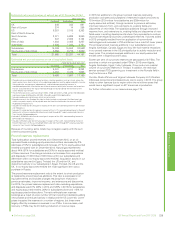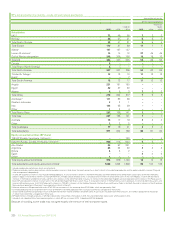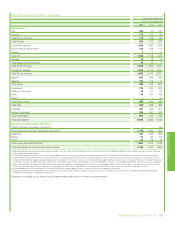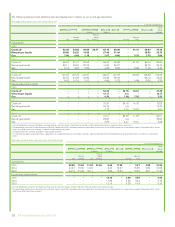BP 2015 Annual Report Download - page 226
Download and view the complete annual report
Please find page 226 of the 2015 BP annual report below. You can navigate through the pages in the report by either clicking on the pages listed below, or by using the keyword search tool below to find specific information within the annual report.
The US Lower 48 onshore business has significant activities across six
states producing natural gas, oil, NGLs and condensate. It is organized
into five, geographic business units, and has a resource base that is
mainly in unconventional reservoirs*(tight gas*, shale gas and coalbed
methane). This resource spans 5.4 million gross developed acres
(3.1 million net) and has approximately 9,000 operated gross wells, with
daily net production around 280mboe/d.
Our US Lower 48 onshore business began operating as a separate
business in 2015. While remaining part of our Upstream segment, it has
its own governance, processes and systems and is designed to increase
competitive performance through swift decision making and innovation,
while maintaining BP’s commitment to safe, reliable and compliant
operations.
• In December the US Lower 48 onshore business expanded its San
Juan basin operations by acquiring all of Devon Energy’s assets in the
region. The bulk of the acquired assets, which span northern New
Mexico and southern Colorado, consist of Devon’s operated interest in
the Northeast Blanco Unit.
For further information on the use of hydraulic fracturing in our shale gas
assets see page 47. BP’s onshore US crude oil and product pipelines and
related transportation assets are included in the Downstream segment.
In Alaska BP operated nine North Slope oilfields in the Greater Prudhoe
Bay area at the end of 2015. Our focus continues to be safe and reliable
operations, renewing BP’s Alaska North Slope infrastructure and
minimizing oil production decline. Infrastructure renewal activities in 2015
included fire and gas system upgrades, safety system upgrades, pipeline
renewal and facility siting projects. Production decline is being managed
through annual drilling programmes and rig and non-rig well work
programmes. BP also owns significant interests in six producing fields
operated by others, as well as significant non-operating interests in the
Point Thomson development project and the Liberty prospect.
• Development of the Point Thomson production facility continued in
2015. Construction of field infrastructure and fabrication of the four
main process modules is progressing on schedule. The project is on
track to commence production in early 2016. BP holds a 32% working
interest in the field and ExxonMobil is the operator.
• BP continued to work jointly with ExxonMobil, ConocoPhillips and the
State of Alaska throughout 2015 to advance the Alaska LNG project.
The project concept includes a North Slope gas treatment plant, an
approximately 800-mile pipeline to tidewater and a three-train
liquefaction facility, with an estimated capacity of 3bcf/d (up to
20 million tonnes per annum). In June 2014 the Alaska LNG co-
venturers, including the State of Alaska, executed commercial
agreements and launched the pre-front-end engineering and design
(pre-FEED) phase of the project, which is expected to extend through
2016 with a gross spend of more than $500 million. In March, the
Federal Energy Regulatory Commission issued a Notice of Intent to
prepare an environmental impact statement for the Alaska LNG
project. In May 2015 the US Department of Energy conditionally
authorized the export of Alaska LNG to non-Free Trade Agreement
countries. In October and November the co-venturers received
approval from the Alaska Oil & Gas Conservation Commission for gas
offtake from the Prudhoe Bay and Point Thomson fields respectively
sufficient to underpin gas export. A decision point for progressing to
the front-end engineering and design (FEED) phase of the project will
be reached in 2017 after completion of the pre-FEED phase. First
commercial gas is planned between 2023 and 2025.
• In December, a number of Alaska assets were subject to impairment
charges totalling $194 million, primarily as a result of the lower price
environment.
BP owns a 49% interest in the Trans-Alaska Pipeline System (TAPS). TAPS
transports crude oil from Prudhoe Bay on the Alaska North Slope to the port
of Valdez in south-east Alaska. In April 2012 the two non-controlling owners
of TAPS, Koch (3.08%) and Unocal (1.37%) gave notice to BP, ExxonMobil
(21.1%) and ConocoPhillips (29.1%) of their intention to withdraw as
owners of TAPS. The transfer of Koch’s interest to the remaining owners
was completed in 2012. The remaining owners and Unocal have not yet
reached agreement regarding the terms for the transfer of Unocal’s interest
in TAPS and related litigation will continue in 2016.
• In November 2015, the Federal Energy Regulatory Commission (FERC)
issued an order addressing the TAPS tariff rate filings for years 2009 and
2010. The decision will result in an increase in BP’s production tax and
royalty liabilities to the State of Alaska, retroactively from 2009 onwards.
In Canada, BP is currently focused on oil sands development using in-situ
steam-assisted gravity drainage (SAGD) technology, which uses the
injection of steam into the reservoir to warm the bitumen so that it can
flow to the surface through producing wells. We hold interests in three
oil sands leases through the Sunrise Oil Sands and Terre de Grace
partnerships and the Pike Oil Sands joint operation*. In addition, we
have significant offshore exploration interests in the Canadian Beaufort
Sea, Nova Scotia and Newfoundland.
• Following the start of steam generation at the Sunrise Phase 1 in-situ
oil sands project in Alberta (BP 50%) in December 2014, oil production
began in March. Production is expected to ramp-up to full capacity of
60,000 barrels per day (gross) in 2017.
• BP completed processing seismic data acquired offshore Nova Scotia
at the end of 2015. We and our partners Hess (40%) and Woodside
(20%) are planning to choose potential exploration well locations in
2016 and, pending regulatory approval, begin the first exploration
drilling programme.
• In partnership with Statoil and ExxonMobil, BP was a successful bidder
for exploration licences in the Flemish Pass Basin offshore
Newfoundland. Statoil will operate all three licences, and ExxonMobil
will participate in two licences as a partner. The licences have an
effective date of 15 January 2016. BP has a 33% share in the
NL15-01-06 and NL15-01-07 licences and a 50% share in the
NL15-01-08 licence.
South America
BP has upstream activities in Brazil and Trinidad & Tobago, as well as in
Argentina, Bolivia, and Chile through an equity-accounted joint venture*.
In Brazil BP has interests in 21 exploration concessions across five
basins.
• We continued appraisal of the Itaipu discovery, located in the
deepwater sector of the Campos basin offshore Brazil in block
BM-C-32, in line with the appraisal plan approved by the Brazilian
National Petroleum Agency (ANP) in 2015. In October BP and its
partner Anadarko submitted an application to ANP to transfer
operatorship from BP to Anadarko. This will achieve significant
efficiencies in progressing the development of this and an adjacent
block, BM-C-30 (Wahoo), where Anadarko is the operator. Also in
October, an extension request was filed with the ANP for three
additional years for each of Itaipu and Wahoo to progress appraisal
activities.
• In May we received final approval from ANP for the previously signed
agreement with Petroleo Brasileiro S.A. (Petrobras) to farm in to five
deepwater exploration blocks in Potiguar basin. The blocks are located in
the Brazilian equatorial margin and cover an area of 3,837km2. The Pitu-2
well was completed during the year and proved the presence of oil.
• After disappointing exploration results in October, BP and Petrobras
submitted an application to ANP to relinquish their interest in
BM-CE-2 block in Ceara basin.
• During the year we progressed the preparatory activities for drilling
exploration wells in the Foz de Amazonas and Barrerinhas blocks
acquired in May 2013.
• We continued discussions with the operators of blocks BM-C-35 and
BC-2, Petrobras and Total respectively, to define the optimal appraisal
of these blocks in the South Campos basin.
In May we notified the Uruguayan oil and gas regulator, ANCAP, that
interpretation of seismic data acquired over BP-operated blocks in
Uruguay had not resulted in identification of viable prospects. As a result
we relinquished our 100% interest in all the blocks in Uruguay and
ANCAP approved this in February 2016.
In Argentina, Bolivia and Chile BP conducts activity through Pan American
Energy LLC (PAE), an equity-accounted joint venture with Bridas
Corporation, in which BP has a 60% interest. In September 2015 PAE
sold its 50% interest in the Coiron licence in Chile. In addition, PAE has
acquired a 60% working interest in the Hokchi production-sharing
agreement*(PSA) in Mexico, effective from January 2016.
222 BP Annual Report and Form 20-F 2015
















